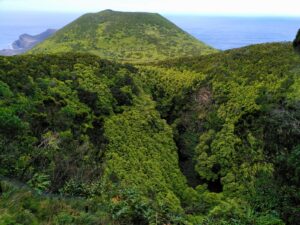
The landscape from the Cabeço Verde volcano on the island of Faial in the Azores is dominated by lush vegetation that contrasts with the dark volcanic rock and the blue Atlantic Ocean.
As in our country, in the Azores invasive plants also have a negative impact on natural habitats and compete directly with endemic plants such as the vidalia (Azorina vidalii), a species for which LIFE Vidalia is working to improve its conservation status by removing invasives from the habitats where it grows.

Vidalia (Azorina vidalii), endemic to the Azores.

Light green canopy of Pittosporum undulatum dominating the vegetation at Cabeço Verde..
One of the most problematic invasive species is Pittosporum undulatum, a shrub that can grow up to seven metres high. It came to the islands to be used as a green hedge, and now grows everywhere in the Azores.
Networking
Last week Gerard Carrion from the Natural Park of Cap de Creus and Roser Melero from the Botanical Institute of Barcelona visited LIFE Vidalia to learn from their experience in vertical work on invasive species removal and to learn about the conservation and environmental education tasks they are carrying out.

LIFE Vidalia and LIFE medCLIFFS teams
Getting to know other initiatives
They also present the LIFE medCLIFFS project and the educational materials we are preparing with La Sorellona, in the framework of the 15th Environmental Education Meeting organised by the Government of Azores.

Roser Melero presenting LIFE medCLIFFS at the XV Encontro Regionais de Educaçao Ambiental
There, they met other LIFE projects, such as LIFE IP Azores Natura, LIFE Beetles, LIFE Snails and LIFE IP CLIMAZ, as well as the Portuguese EcoEscolas and other very interesting environmental education initiatives.
They come back with new knowledge, new partners and many ideas to apply at home, we hope to be able to put them into practice soon!




